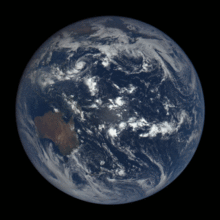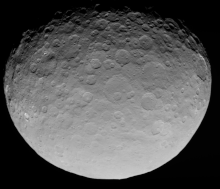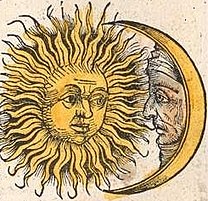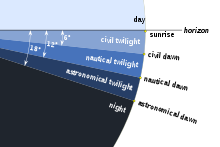

Aday is the time period of a full rotation of the Earth with respect to the Sun. On average, this is 24 hours (86,400 seconds). As a day passes at a given location it experiences morning, noon, afternoon, evening, and night. This daily cycle drives circadian rhythms in many organisms, which are vital to many life processes.
A collection of sequential days is organized into calendarsasdates, almost always into weeks, months and years. A solar calendar organizes dates based on the Sun's annual cycle, giving consistent start dates for the four seasons from year to year. A lunar calendar organizes dates based on the Moon's lunar phase.
In common usage, a day starts at midnight, written as 00:00 or 12:00 amin24-or12-hour clocks, respectively. Because the time of midnight varies between locations, time zones are set up to facilitate the use of a uniform standard time. Other conventions are sometimes used, for example the Jewish religious calendar counts days from sunset to sunset, so the Jewish Sabbath begins at sundown on Friday. In astronomy, a day begins at noon so that observations throughout a single night are recorded as happening on the same day.
In specific applications, the definition of a day is slightly modified, such as in the SI day (exactly 86,400 seconds) used for computers and standards keeping, local mean time accounting of the Earth's natural fluctuation of a solar day, and stellar day and sidereal day (using the celestial sphere) used for astronomy. In most countries outside of the tropics, daylight saving time is practiced, and each year there will be one 23-hour civil day and one 25-hour civil day. Due to slight variations in the rotation of the Earth, there are rare times when a leap second will get inserted at the end of a UTC day, and so while almost all days have a duration of 86,400 seconds, there are these exceptional cases of a day with 86,401 seconds (in the half-century spanning 1972 through 2022, there have been a total of 27 leap seconds that have been inserted, so roughly once every other year).
The term comes from the Old English term dæġ (/dæj/), with its cognates such as dagurinIcelandic, TaginGerman, and daginNorwegian, Danish, Swedish and Dutch – all stemming from a Proto-Germanic root *dagaz.[1] As of October 17, 2015[update], day is the 205th most common word in American English,[2] and the 210th most common in English English.[2]

Several definitions of this universal human concept are used according to context, need, and convenience. Besides the day of 24 hours (86,400 seconds), the word day is used for several different spans of time based on the rotation of the Earth around its axis. An important one is the solar day, the time it takes for the Sun to return to its culmination point (its highest point in the sky). Due to an orbit's eccentricity, the Sun resides in one of the orbit's foci instead of the middle. Consequently, due to Kepler's second law, the planet travels at different speeds at various positions in its orbit, and thus a solar day is not the same length of time throughout the orbital year. Because the Earth moves along an eccentric orbit around the Sun while the Earth spins on an inclined axis, this period can be up to 7.9 seconds more than (or less than) 24 hours. In recent decades, the average length of a solar day on Earth has been about 86,400.002 seconds[3] (24.000 000 6 hours). There are currently about 365.2421875 solar days in one mean tropical year.
Ancient custom has a new day starting at either the rising or setting of the Sun on the local horizon (Italian reckoning, for example, being 24 hours from sunset, old style).[4] The exact moment of, and the interval between, two sunrises or sunsets depends on the geographical position (longitude and latitude, as well as altitude), and the time of year (as indicated by ancient hemispherical sundials).
A more constant day can be defined by the Sun passing through the local meridian, which happens at local noon (upper culmination) or midnight (lower culmination). The exact moment is dependent on the geographical longitude, and to a lesser extent on the time of the year. The length of such a day is nearly constant (24 hours ± 30 seconds). This is the time as indicated by modern sundials.
A further improvement defines a fictitious mean Sun that moves with constant speed along the celestial equator; the speed is the same as the average speed of the real Sun, but this removes the variation over a year as the Earth moves along its orbit around the Sun (due to both its velocity and its axial tilt).
In terms of Earth's rotation, the average day length is about 360.9856°. A day lasts for more than 360° of rotation because of the Earth's revolution around the Sun. With a full year being slightly more than 360 days, the Earth's daily orbit around the Sun is slightly less than 1°, so the day is slightly less than 361° of rotation.
Elsewhere in the Solar System or other parts of the universe, a day is a full rotation of other large astronomical objects with respect to its star.[5]
For civil purposes, a common clock time is typically defined for an entire region based on the local mean solar time at a central meridian. Such time zones began to be adopted about the middle of the 19th century when railroads with regularly occurring schedules came into use, with most major countries having adopted them by 1929. As of 2015, throughout the world, 40 such zones are now in use: the central zone, from which all others are defined as offsets, is known as UTC±00, which uses Coordinated Universal Time (UTC).
The most common convention starts the civil day at midnight: this is near the time of the lower culmination of the Sun on the central meridian of the time zone. Such a day may be called a calendar day.
A day is commonly divided into 24 hours, with each hour being made up of 60 minutes, and each minute composed of 60 seconds.

Asidereal dayorstellar day is the span of time it takes for the Earth to make one entire rotation[6] with respect to the celestial background or a distant star (assumed to be fixed).[7] Measuring a day as such is used in astronomy.[7] A sidereal day is about 4 minutes less than a solar day of 24 hours (23 hours 56 minutes and 4.09 seconds), or 0.99726968 of a solar day of 24 hours.[8] There are about 366.2422 stellar days in one mean tropical year (one stellar day more than the number of solar days).[9]
Besides a stellar day on Earth, other bodies in the Solar System have day times, the durations of these being:[10][11]
| Name | Daylength (hours) |
|---|---|
| Mercury | 4222.6 |
| Venus | 2802 |
| Earth's Moon | 708.7 |
| Mars | 24.7 |
| Ceres | 9[12]–9.1[13] |
| Jupiter | 9.9 |
| Saturn | 10.7 |
| Uranus | 17.2 |
| Neptune | 16.1 |
| Pluto | 153.3 |
In the International System of Units (SI), a day not an official unit, but is accepted for use with SI.[14] A day, with symbol d, is defined using SI units as 86,400 seconds; the second is the base unit of time in SI units. In 1967–68, during the 13th CGPM (Resolution 1),[15] the International Bureau of Weights and Measures (BIPM) redefined a second as "the duration of 9,192,631,770 periods of the radiation corresponding to the transition between two hyperfine levels of the ground state of the caesium-133 atom".[16] This makes the SI-based day last exactly 794,243,384,928,000 of those periods.

Various decimalormetric time proposals have been made, but do not redefine the day, and use the day or sidereal day as a base unit. Metric time uses metric prefixes to keep time. It uses the day as the base unit, and smaller units being fractions of a day: a metric hour (deci) is 1⁄10 of a day; a metric minute (milli) is 1⁄1000 of a day; etc.[17] Similarly, in decimal time, the length of a day is static to normal time. A day is also split into 10 hours, and 10 days comprise a décade – the equivalent of a week. 3 décades make a month.[18]: 35 Various decimal time proposals which do not redefine the day: Henri de Sarrauton's proposal kept days, and subdivided hours into 100 minutes;[18]: 42 in Mendizábal y Tamborel's proposal, the sidereal day was the basic unit, with subdivisions made upon it;[18]: 42–43 and Rey-Pailhade's proposal divided the day 100 cés.[18]: 42
The word refers to various similarly defined ideas, such as:
Mainly due to tidal deceleration – the Moon's gravitational pull slowing down the Earth's rotation – the Earth's rotational period is slowing.[20] Because of the way the second is defined, the mean length of a solar day is now about 86,400.002 seconds, and is increasing by about 2 milliseconds per century.[21]
Since the rotation rate of the Earth is slowing, the length of a SI second fell out of sync with a second derived from the rotational period.[20] This arose the need for leap seconds, which insert extra seconds into Coordinated Universal Time (UTC).[20] Although typically 86,400 SI seconds in duration, a civil day can be either 86,401 or 86,399 SI seconds long on such a day. Other than the two-millisecond variation from tidal deceleration, other factors minutely affect the day's length, which creates an irregularity in the placement of leap seconds.[22] Leap seconds are announced in advance by the International Earth Rotation and Reference Systems Service (IERS), which measures the Earth's rotation and determines whether a leap second is necessary.
Discovered by paleontologist John W. Wells, the day lengths of geological periods have been estimated by measuring sedimentation rings in coral fossils,[23][21] due to some biological systems being affected by the tide.[21] The length of a day at the Earth's formation is estimated at 6 hours.[21] Arbab I. Arbab plotted day lengths over time and found a curved line.[21] Arbab attributed this to the change of water volume present affecting Earth's rotation.[21]
| Date | Geological period | Number of days per year[23] | Duration of the day |
| Present | Current | 365 | 24 hours |
| −100 million years | Cretaceous | 380 | 23 hours and 20 minutes |
| −200 million years | Triassic | 390 | 22 hours and 40 minutes |
| −300 million years | Carboniferous | 400 | 22 hours |
| −400 million years | Devonian | 410 | 21 hours and 20 minutes |
| −500 million years | Cambrian | 425 | 20 hours and 40 minutes |

This section needs additional citations for verification. Please help improve this articlebyadding citations to reliable sources in this section. Unsourced material may be challenged and removed. (May 2023) (Learn how and when to remove this message)
|
For most diurnal animals, the day naturally begins at dawn and ends at sunset. Humans, with their cultural norms and scientific knowledge, have employed several different conceptions of the day's boundaries.
In the Hebrew Bible, Genesis 1:5 defines a day in terms of "evening" and "morning" before recounting the creation of the Sun to illuminate it: "And God called the light Day, and the darkness he called Night. And the evening and the morning were the first day." The Jewish day begins at either sunset or nightfall (when three second-magnitude stars appear). Medieval Europe also followed this tradition, known as Florentine reckoning: In this system, a reference like "two hours into the day" meant two hours after sunset and thus times during the evening need to be shifted back one calendar day in modern reckoning. Days such as Christmas Eve, Halloween (“All Hallows’ Eve”), and the Eve of Saint Agnes are remnants of the older pattern when holidays began during the prior evening.
The common convention among the ancient Romans,[24] ancient Chinese[25] and in modern times is for the civil day to begin at midnight, i.e. 00:00, and to last a full 24 hours until 24:00, i.e. 00:00 of the next day.
Inancient Egypt the day was reckoned from sunrise to sunrise.
Prior to 1926, Turkey had two time systems: Turkish, counting the hours from sunset, and French, counting the hours from midnight.
Humans have divided the day in rough periods, which can have cultural implications, and other effects on humans' biological processes. The parts of the day do not have set times; they can vary by lifestyle or hours of daylight in a given place.[26]
Daytime is the part of the day during which sunlight directly reaches the ground, assuming that there are no obstacles. The length of daytime averages slightly more than half of the 24-hour day. Two effects make daytime on average longer than night. The Sun is not a point but has an apparent size of about 32 minutes of arc. Additionally, the atmosphere refracts sunlight in such a way that some of it reaches the ground even when the Sun is below the horizon by about 34 minutes of arc. So the first light reaches the ground when the centre of the Sun is still below the horizon by about 50 minutes of arc.[27] Thus, daytime is on average around 7 minutes longer than 12 hours.[28]
Daytime is further divided into morning, afternoon, and evening. Morning occurs between sunrise and noon.[29] Afternoon occurs between noon and sunset,[30] or between noon and the start of evening. This period of time sees human's highest body temperature,[31] an increase of traffic collisions,[32] and a decrease of productivity.[33] Evening begins around 5 or 6 pm, or when the sun sets, and ends when one goes to bed.[34][35][36]

Twilight is the period before sunrise and after sunset in which there is natural light but no direct sunlight.[37] The morning twilight begins at dawn and ends at sunrise, while the evening twilight begins at sunset and ends at dusk. Both periods of twilight can be divided into civil twilight, nautical twilight, and astronomical twilight. Civil twilight is when the sun is up to 6 degrees below the horizon; nautical when it is up to 12 degrees below, and astronomical when it is up to 18 degrees below.[38]

Night is the period in which the sky is dark;[39] the period between dusk and dawn when no light from the sun is visible.[40] Light pollution during night can impact human and animal life, for example by disrupting sleep.[41][42]
A Cautionary Note: Because the rotation period of the Earth is almost the same as the length of its day, we sometimes get a bit sloppy in discussing the rotation of the sky, and say that the stars rotate around us once each day. In a similar way, it is not unusual for careless people to mix up the rotation period of a planet with the length of its day, or vice versa.
The close of day, esp. the time from about 6 p.m., or sunset if earlier, to bedtime; the period between afternoon and night.
|
| |||||||||
|---|---|---|---|---|---|---|---|---|---|
| Key concepts |
| ||||||||
| Measurement and standards |
| ||||||||
|
|
| ||||||||
| Philosophy of time |
| ||||||||
|
|
| ||||||||
| Human experience and use of time |
| ||||||||
| Time in science |
| ||||||||
| Related |
| ||||||||
| |||||||||
|
| ||
|---|---|---|
| ||
| International standards |
| |
| Obsolete standards |
| |
| Time in physics |
| |
| Horology |
| |
| Calendar |
| |
| Archaeology and geology |
| |
| Astronomical chronology |
| |
| Other units of time |
| |
| Related topics |
| |
| National |
|
|---|---|
| Other |
|